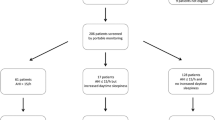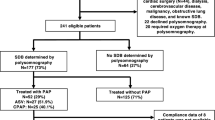Abstract
Background
Sleep-disordered breathing (SDB) is associated with prothrombotic effects that could lead to venous thromboembolic diseases.
Objective
The objective of this study is to clarify the prevalence of SDB among survivors of pulmonary embolism (PE).
Methods
One hundred six consecutive PE patients were prospectively evaluated by portable monitoring (PM). Nocturnal polysomnography was performed in all subjects who were diagnosed by PM to have an apnoea-hypopnoea index (AHI) > 15/h or evidence of increased daytime sleepiness.
Results
The overall SDB prevalence in the study population was 58.5 %. Mild obstructive sleep apnoea (OSA) was diagnosed in 35.8 % of patients. Of the subjects, 12.3 % suffered from moderate OSA. In 10.4 % of study participants, OSA was found to be severe. High-risk PE was significantly more frequent among subjects with an AHI > 15/h (p = 0.005).
Conclusion
OSA is a common comorbidity of PE and possibly represents an additional risk factor for hemodynamic instability in PE patients.

Similar content being viewed by others
References
Newton K, Malik V, Lee-Chiong T (2014) Sleep and breathing. Clin Chest Med 35(3):451–456
Caples SM, Gami AS, Somers VK (2005) Obstructive sleep apnea. Ann Intern Med 142(3):187–197
Floras JS (2014) Sleep apnea and cardiovascular risk. J Cardiol 63(1):3–8
Somers VK, Dyken ME, Clary MP, Abboud FM (1995) Sympathetic neural mechanisms in obstructive sleep apnea. J Clin Invest 96(4):1897–1904
Marrone O, Bonsignore MR (2002) Pulmonary haemodynamics in obstructive sleep apnoea. Sleep Med Rev 6(3):175–193
von Känel R, Loredo JS, Ancoli-Israel S, Mills PJ, Natarajan L, Dimsdale JE (2007) Association between polysomnographic measures of disrupted sleep and prothrombotic factors. Chest 131(3):733–739
Ryan S, Taylor CT, McNicholas WT (2005) Selective activation of inflammatory pathways by intermittent hypoxia in obstructive sleep apnea syndrome. Circulation 112(17):2660–2667
Budhiraja R, Parthasarathy S, Quan SF (2007) Endothelial dysfunction in obstructive sleep apnea. J Clin Sleep Med 3(4):409–415
Toraldo DM, Peverini F, De Benedetto M, De Nuccio F (2013) Obstructive sleep apnea syndrome: blood viscosity, blood coagulation abnormalities, and early atherosclerosis. Lung 191(1):1–7
Bosanquet JP, Bade BC, Zia MF, Karo A, Hassan O, Hess BT, Dabbagh O (2011) Patients with venous thromboembolism appear to have higher prevalence of obstructive sleep apnea than the general population. Clin Appl Thromb Hemost 17(6):119–124
Chou KT, Huang CC, Chen YM, Su KC, Shiao GM, Lee YC, Chan WL, Leu HB (2012) Sleep apnea and risk of deep vein thrombosis: a non-randomized, pair-matched cohort study. Am J Med 125(4):374–380
Berghaus TM, Faul C, Unterer F, Thilo C, von Scheidt W, Schwaiblmair M (2012) Acute pulmonary embolism in patients with obstructive sleep apnoea: does it affect the severity of sleep disordered breathing? Sleep Breath 16(4):1267–1269
Johns MW (1991) A new method for measuring daytime sleepiness: the Epworth Sleepiness Scale. Sleep 14(6):540–545
Konstantinides SV, Torbicki A, Agnelli G, Danchin N, Fitzmaurice D, Galiè N, Gibbs JS, Huisman MV, Humbert M, Kucher N, Lang I, Lankeit M, Lekakis J, Maack C, Mayer E, Meneveau N, Perrier A, Pruszczyk P, Rasmussen LH, Schindler TH, Svitil P, Vonk Noordegraaf A, Zamorano JL, Zompatori M, Task force for the diagnosis and management of acute pulmonary embolism of the European Society of Cardiology (2014) 2014 ESC guidelines on the diagnosis and management of acute pulmonary embolism. Eur Heart J 35(43):3033–3069, 3069a-3069k
Anderson FA, Spencer FA (2003) Risk factors for venous thromboembolism. Circulation 107(23):9–16
Erman MK, Stewart D, Einhorn D, Gordon N, Casal E (2007) Validation of the ApneaLink for the screening of sleep apnea: a novel and simple single-channel recording device. J Clin Sleep Med 3(4):387–392
American Academy of Sleep Medicine (2012) The AASM Manual for the Scoring of Sleep and Associated Events: Rules, Terminology, and Technical Specifications, Version 2.1., Westchester, IL
Iber C, Ancoli-Israel S, Chesson AL Jr., Quan SF, for the American Academy of Sleep Medicine (2007) The AASM manual for the scoring of sleep and associated events: rules, terminology and technical specifications. 1st ed. Westchester
Arnulf I, Merino-Andreu M, Perrier A, Birolleau S, Similowski T, Derenne JP (2002) Obstructive sleep apnea and venous thromboembolism. JAMA 287(20):2655–2656
Epstein MD, Segal LN, Ibrahim SM, Friedman N, Bustami R (2010) Snoring and the risk of obstructive sleep apnea in patients with pulmonary embolism. Sleep 33(8):1069–1074
Arzt M, Luigart R, Schum C, Lüthje L, Stein A, Koper I, Hecker C, Dumitrascu R, Schulz R, Circulation and Sleep working group of the German Society of Sleep Research and Sleep Medicine (DGSM) (2012) Sleep-disordered breathing in deep vein thrombosis and acute pulmonary embolism. Eur Respir J 40(4):919–922
Young T, Palta M, Dempsey J, Skatrud J, Weber S, Badr S (1993) The occurrence of sleep-disordered breathing among middle-aged adults. N Engl J Med 328(17):1230–1235
Punjabi NM (2008) The epidemiology of adult obstructive sleep apnea. Proc Am Thorac Soc 5(2):136–143
Olson LG, King MT, Hensley MJ, Saunders NA (1995) A community study of snoring and sleep-disordered breathing. Prevalence. Am J Respir Crit Care Med 152(2):711–716
Ip MS, Lam B, Lauder IJ, Tsang KW, Chung KF, Mok YW, Lam WK (2001) A community study of sleep-disordered breathing in middle-aged Chinese men in Hong Kong. Chest 119(1):62–69
Ip MS, Lam B, Tang LC, Lauder IJ, Ip TY, Lam WK (2004) A community study of sleep-disordered breathing in middle-aged Chinese women in Hong Kong: prevalence and gender differences. Chest 125(1):127–134
Young T, Shahar E, Nieto FJ, Redline S, Newman AB, Gottlieb DJ, Walsleben JA, Finn L, Enright P, Samet JM, Sleep Heart Health Study Research Group (2002) Predictors of sleep-disordered breathing in community-dwelling adults: the Sleep Heart Health Study. Arch Intern Med 162(8):893–900
Somers VK, White DP, Amin R, Abraham WT, Costa F, Culebras A, Daniels S, Floras JS, Hunt CE, Olson LJ, Pickering TG, Russell R, Woo M, Young T (2008) Sleep apnea and cardiovascular disease: an American Heart Association/American College of Cardiology Foundation Scientific Statement from the American Heart Association Council for High Blood Pressure Research Professional Education Committee, Council on Clinical Cardiology, Stroke Council, and Council on Cardiovascular Nursing. J Am Coll Cardiol 52(8):686–717
Kasper W, Konstantinides S, Geibel A, Olschewski M, Heinrich F, Grosser KD, Rauber K, Iversen S, Redecker M, Kienast J (1997) Management strategies and determinants of outcome in acute major pulmonary embolism: results of a multicenter registry. J Am Coll Cardiol 30(5):1165–1171
Timmons S, Kingston M, Hussain M, Kelly H, Liston R (2003) Pulmonary embolism: differences in presentation between older and younger patients. Age Ageing 32(6):601–605
Acknowledgments
The authors gratefully acknowledge the excellent assistance of Mrs. Tanja Wagner during the preparation and execution of the study. Dr. Peter Julian Petri provided most valuable support in proof reading the manuscript.
Author contributions
Drs. Berghaus, von Scheidt, and Schwaiblmair conceived and designed the study. Drs. Berghaus, Faul, and Schwaiblmair acquired the study data. Dr. Berghaus performed the statistical analysis and drafted the article. All authors participated in interpreting the data and revised the manuscript for important intellectual content. All authors approved the final version of the manuscript.
Conflict of interest
All authors have no conflict of interest to declare.
Author information
Authors and Affiliations
Corresponding author
Rights and permissions
About this article
Cite this article
Berghaus, T.M., Faul, C., von Scheidt, W. et al. The prevalence of sleep-disordered breathing among survivors of acute pulmonary embolism. Sleep Breath 20, 213–218 (2016). https://doi.org/10.1007/s11325-015-1209-8
Received:
Revised:
Accepted:
Published:
Issue Date:
DOI: https://doi.org/10.1007/s11325-015-1209-8




